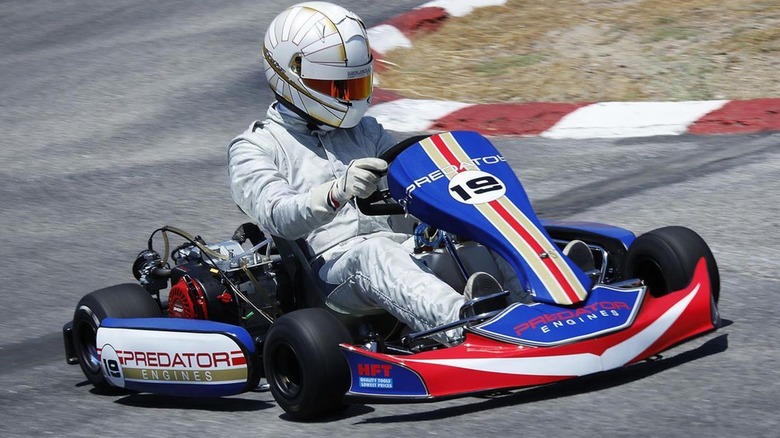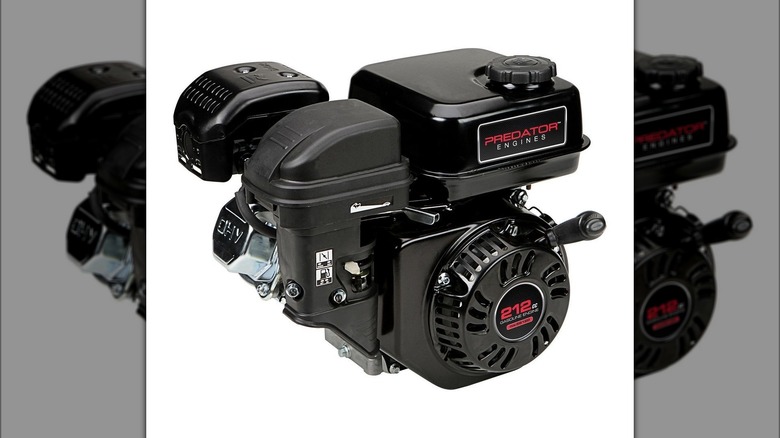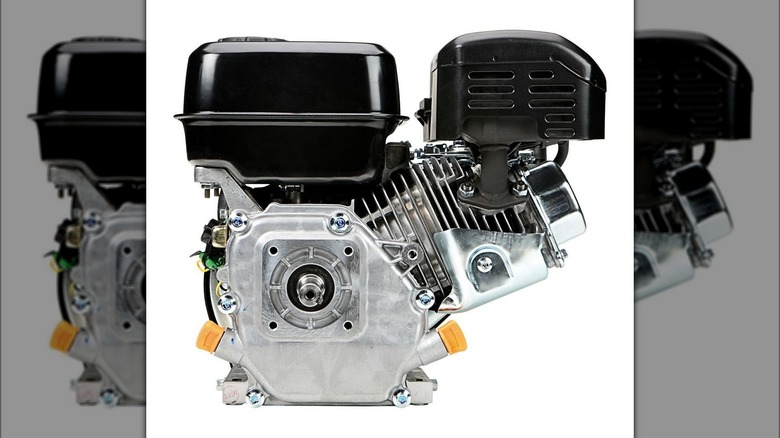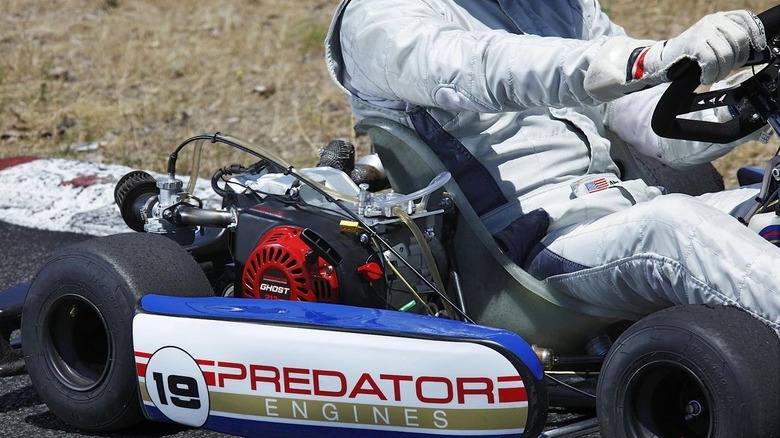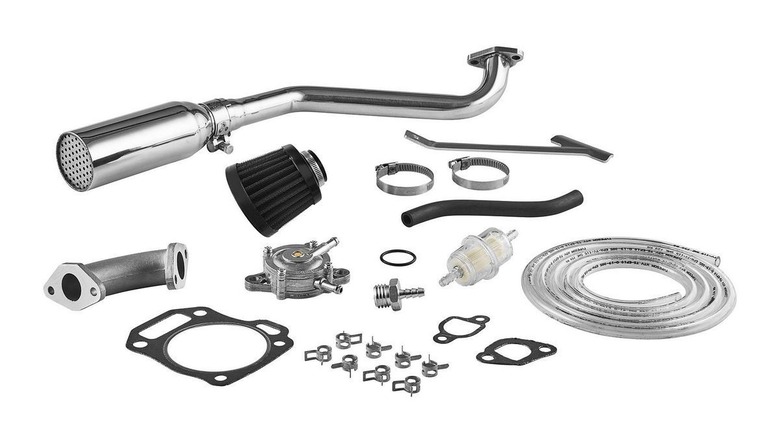Predator 212 Vs. Predator 212 Ghost: Harbor Freight Engines, Compared
The idea of visiting a hardware store with the intent to purchase an entire pre-built engine feels a little strange on paper, but as it happens, Harbor Freight actually has quite a few small engines packed up and ready to go at a moment's notice. In fact, the chain has its own in-store brand specifically for gas-powered engines and generators, Predator. Whether you need something to power to your generator or replace your lawnmower's engine, you can get a Predator device for the job.
In the specific case of engines, Harbor Freight offers twelve different models of Predator power, each with their own level of output, fuel consumption, and torque. Of course, there's only so much variance you can get in the small engine sphere, so there is some crossover. For example, Harbor Freight sells two small engines rated at 212cc: the Predator 212cc OHV Horizontal Shaft Gas Engine, and the Predator 212cc Ghost Kart Racing Engine. The names of the engines alone give you an idea of what differentiates them, but there's actually a little more going on under the proverbial hood, including features and general performance.
The 212 Ghost is for go-karts, the regular 212 is for everything else
In broad strokes, the intended purposes of these engines are right in their titles. The Predator 212 Ghost is an engine specifically designed for use on race-ready go-karts. It has been built for the express purpose of putting out as much consistent power as possible in order to power a go-kart on a racetrack. Additionally, it's designed to seamlessly drop-fit into most commercially available go-kart chassis. If you're building a dream machine in your garage, the 212 Ghost will get you competitive speeds for sub-250cc racing classes.
The regular Predator 212, on the other hand, is intended for just about anything else you might want to slot an engine into. This includes, but is not limited to, lawn mowers, pressure washers, woodchippers, portable generators, and more. This is an engine that's designed to deliver smooth and consistent power, as opposed to the Ghost's throttle-ready design. In another difference from the Ghost, which can be the first option for a brand-new go-kart, the regular 212 is intended more to serve as a budget replacement for existing engines in the aforementioned tools.
The regular 212 has more safety features
Since the regular Predator 212 engine is intended to be used in a variety of work tools, safety is the order of the day. It's not like the 212 Ghost, which is designed to output as much speed as possible — the regular 212 is not intended for fun, but for safe, reliable work.
As a reflection of this, the regular 212 has more built-in safety features to ensure its clean operation, general longevity, and user well-being. For example, the regular 212 is equipped with a low oil sensor. If and when the engine's oil levels dip too low for continued safe operation, it automatically shuts off. Even if there's still gas in the tank, as long as the oil's too low, it won't start back up until it's refilled. The Ghost is not equipped with this kind of feature – there's a big difference between having your engine shut off while you're mowing the lawn and while you're out on an active racetrack.
The regular 212 is also designed to be generally more user-friendly, with simple controls and an easy startup. Nobody likes fiddling with their engine while they're trying to perform some kind of backyard task. It also utilizes overhead valves in its construction, which help to both keep the engine cooler during operation and, by extension, save you a bit of gas that would otherwise be burned up.
The regular 212 is much cheaper than the 212 Ghost
Considering the regular 212 is intended to go into yard work equipment and small farm tools, while the 212 Ghost is meant to be used in a high-performance go-kart, it shouldn't be especially surprising that the former is cheaper than the latter.
When purchased from Harbor Freight, the regular Predator 212 engine costs $149.99. Fun fact, that's less than half the cost of one of the engine's major contemporaries, the Honda GX200 QX2 engine, which normally retails for as high as $500. That's what makes the regular 212 an attractive substitute for a major name-brand engine around 200cc.
The 212 Ghost, meanwhile, is much more expensive at $329.99. Again, this is meant to be a high-performance engine, something to be used in a go-kart right at the cusp of the 250cc classification. It's one thing to get an engine for a tool you'll only use once in a while, but if you want an engine that you're going to be pushing to its absolute limit on a regular basis, then a higher cost is pretty much a given. On the bright side, like the regular 212, the 212 Ghost is still cheaper than its major contemporaries. A comparable engine like the Briggs & Stratton 124332-8003 normally goes for twice that price at around $659. Additionally, if you have a Harbor Freight Inside Track Club membership, you may be able to get a discount on the Ghost's price tag.
The 212 Ghost has high-performance features
The regular Predator 212 is safer and cheaper than the 212 Ghost, but that doesn't mean the Ghost brings nothing to the party of its own. The Ghost is a feisty, four-stroke beast of a go-kart engine, with Harbor Freight billing it as the ultimate performance in engines below 250cc.
Every aspect of the Ghost is specially tooled to provide the strongest possible performance out on the track. The cylinder has a reinforced dual-ball bearing with a cast iron sleeve for peak durability, the ground cam has a built-in mechanical compression release, and the crankshaft is made of forged carbon steel with an induction-hardened crankpin. It even has a built-in digital timing advance ignition system, complete with a built-in rev limiter that keeps things spinning at 6000 RPM.
Harbor Freight doesn't have stats listed for the Ghost's general performance, but according to user reviews and forum feedback, it can achieve top speeds of up to 45 MPH, even going uphill, with torque of around 14 ft-lbs. Compared to the regular 212's 8.1 ft-lbs of torque at 2500 RPM, the difference in performance is clear.
The 212 Ghost has a separate accessory kit for fast repairs
One small, yet vital aspect where the 212 Ghost has the regular 212 beat is in availability of parts. With the regular 212, if something breaks or fails, getting replacement parts can be a bit of a hassle. While Harbor Freight does sell replacement parts for its Predator products, you would need to call up your local store for pricing and availability and special-order whatever you need.
With the 212 Ghost, if you need extra parts, you can purchase them straight out at any Harbor Freight location in the form of the 212 Ghost Accessory Kit. This is a pit crew-ready pack of assorted parts including exhaust pipes, fuel lines and pumps, air filters, gaskets, and more. According to users, you can actually use these parts on a regular 212 as well, but since they're branded with the Ghost's name, we'll count it as a point in its favor. The only real drawback is that this parts pack costs $199.99, but at least it has just about everything you could need for a spontaneous repair job.
